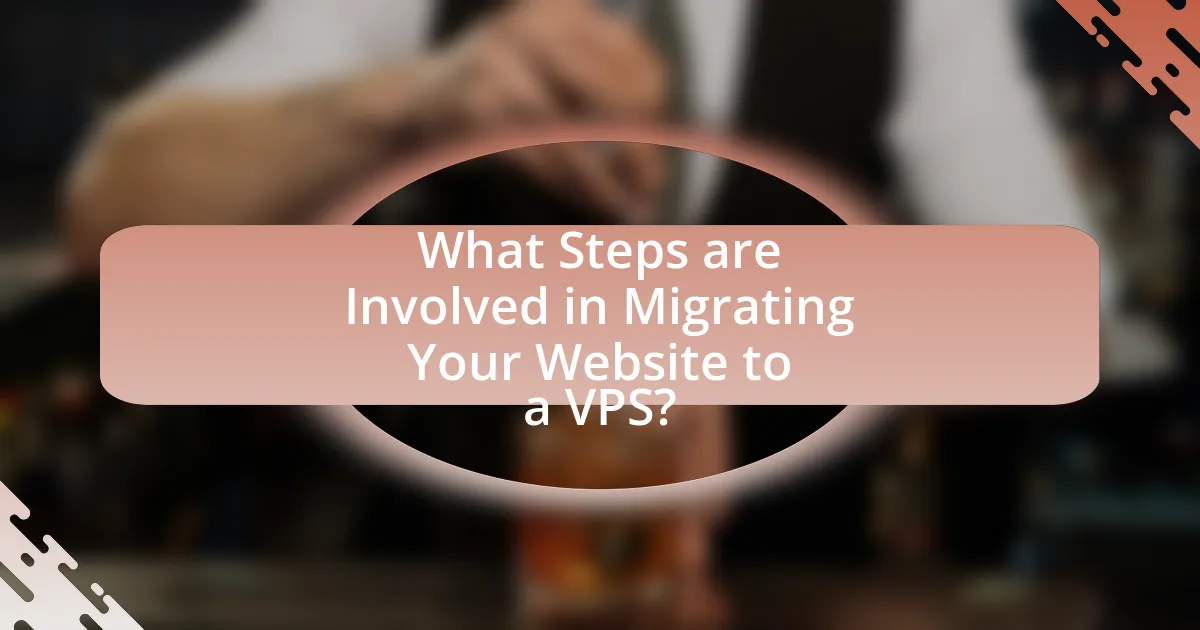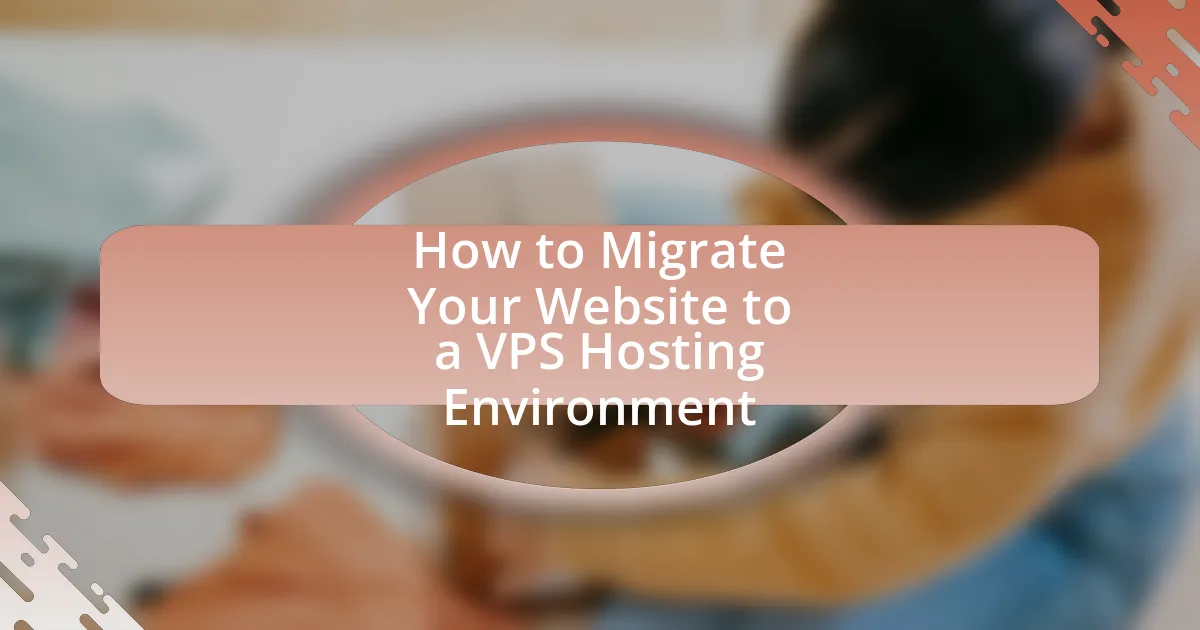VPS hosting, or Virtual Private Server hosting, offers dedicated resources on a virtual server, providing users with enhanced control, performance, and security compared to shared hosting. This article outlines the benefits of VPS hosting, including its key features such as root access, scalability, and improved security measures. It also details the migration process to a VPS, covering essential steps like planning, backing up data, setting up the new environment, and troubleshooting common issues. Additionally, the article emphasizes best practices for ensuring minimal downtime and ongoing maintenance for optimal performance post-migration.

What is VPS Hosting and Why Consider It for Your Website?
VPS hosting, or Virtual Private Server hosting, is a type of web hosting that provides dedicated resources on a virtual server, allowing users to have more control and flexibility compared to shared hosting. It is particularly beneficial for websites that require higher performance, enhanced security, and the ability to customize server settings. VPS hosting operates by partitioning a physical server into multiple virtual servers, each with its own operating system and resources, which ensures that the performance of one server does not affect others. This setup is ideal for businesses experiencing growth or those that anticipate increased traffic, as it can handle more visitors and applications without compromising speed or reliability. Additionally, VPS hosting often includes root access, enabling users to install software and configure settings according to their specific needs, which is not possible with shared hosting.
How does VPS hosting differ from shared and dedicated hosting?
VPS hosting differs from shared and dedicated hosting primarily in resource allocation and control. In VPS hosting, a single physical server is divided into multiple virtual servers, each with its own dedicated resources, allowing for greater performance and customization compared to shared hosting, where resources are shared among all users. Conversely, dedicated hosting provides an entire physical server exclusively for one user, offering maximum control and performance but at a higher cost. This distinction is crucial for users needing specific configurations or higher reliability, as VPS hosting strikes a balance between the affordability of shared hosting and the exclusivity of dedicated hosting.
What are the key features of VPS hosting?
The key features of VPS hosting include dedicated resources, root access, scalability, and enhanced security. Dedicated resources ensure that users have their own allocated CPU, RAM, and storage, which improves performance compared to shared hosting. Root access allows users to install and configure software as needed, providing greater control over the server environment. Scalability enables users to easily upgrade resources as their website grows, accommodating increased traffic without downtime. Enhanced security features, such as isolated environments and customizable firewalls, protect against vulnerabilities and attacks, making VPS hosting a reliable choice for businesses.
Why is VPS hosting beneficial for website performance?
VPS hosting is beneficial for website performance because it provides dedicated resources that enhance speed and reliability. Unlike shared hosting, where multiple websites compete for the same server resources, VPS hosting allocates specific CPU, RAM, and storage to each virtual server. This isolation minimizes resource contention, leading to faster load times and improved user experience. Additionally, VPS environments allow for greater customization and optimization, enabling users to configure settings that best suit their website’s needs, further enhancing performance.
What are the common reasons for migrating to a VPS?
Common reasons for migrating to a VPS include enhanced performance, improved security, and greater control over server resources. VPS hosting provides dedicated resources, which leads to faster load times and better handling of traffic spikes compared to shared hosting. Additionally, VPS environments offer advanced security features, such as isolated environments and customizable firewalls, reducing vulnerability to attacks. Users also benefit from root access, allowing for tailored configurations and the installation of specific software, which is not possible in shared hosting. These factors collectively contribute to a more reliable and efficient hosting solution for businesses and developers.
How does increased traffic influence the need for VPS hosting?
Increased traffic significantly heightens the need for VPS hosting due to its ability to provide dedicated resources and improved performance. When a website experiences a surge in visitors, shared hosting environments often struggle to handle the load, leading to slow response times and potential downtime. VPS hosting allocates specific amounts of CPU, RAM, and bandwidth to each user, ensuring that high traffic does not compromise website functionality. According to a study by HostingAdvice, websites on VPS hosting can handle up to 30% more traffic compared to those on shared hosting, demonstrating the effectiveness of VPS in managing increased visitor numbers.
What security advantages does VPS hosting provide?
VPS hosting provides enhanced security advantages through isolated environments, which protect user data and applications from neighboring accounts. Each VPS operates independently, meaning that if one server is compromised, others remain secure. Additionally, VPS hosting typically includes advanced security features such as firewalls, DDoS protection, and regular security updates, which further safeguard against threats. According to a study by HostingAdvice, 70% of VPS users reported improved security compared to shared hosting, highlighting the effectiveness of these measures in protecting sensitive information.

What Steps are Involved in Migrating Your Website to a VPS?
The steps involved in migrating your website to a VPS include planning the migration, backing up your existing website, setting up the VPS environment, transferring files and databases, configuring the server settings, testing the website on the VPS, and finally updating the DNS records.
Planning the migration involves assessing your current website’s requirements and choosing the appropriate VPS plan. Backing up your existing website ensures that you have a copy of all files and databases in case of any issues during the migration. Setting up the VPS environment requires installing the necessary software and configuring the server to meet your website’s needs.
Transferring files and databases can be done using FTP or SSH, ensuring that all content is moved to the new server. Configuring server settings includes setting up security measures, optimizing performance, and ensuring compatibility with your website’s technologies. Testing the website on the VPS is crucial to identify any issues before going live. Finally, updating the DNS records directs traffic to the new VPS, completing the migration process.
How do you prepare for the migration process?
To prepare for the migration process to a VPS hosting environment, conduct a comprehensive assessment of your current website setup. This includes backing up all website files, databases, and configurations to ensure data integrity during the transition. Additionally, evaluate the new VPS environment’s specifications, such as CPU, RAM, and storage, to ensure they meet your website’s requirements. It is also essential to test the migration process in a staging environment to identify potential issues before the actual migration. According to a study by the Web Hosting Industry Review, 70% of website migrations fail due to inadequate preparation, highlighting the importance of thorough planning and testing.
What data should you back up before migration?
Before migration, you should back up website files, databases, and configuration settings. Website files include HTML, CSS, JavaScript, images, and any other media. Databases contain all dynamic content and user data, typically stored in MySQL or similar systems. Configuration settings involve server settings, application configurations, and any custom scripts. Backing up these components ensures that you can restore your website to its previous state in case of any issues during the migration process.
How do you choose the right VPS provider for your needs?
To choose the right VPS provider for your needs, evaluate key factors such as performance, support, scalability, and pricing. Performance is critical; select a provider that offers high uptime guarantees and fast server speeds, typically above 99.9% uptime and SSD storage for improved speed. Support is essential; opt for a provider that offers 24/7 customer service through multiple channels, ensuring assistance is available when needed. Scalability allows for future growth; choose a provider that enables easy upgrades to resources like CPU, RAM, and storage without significant downtime. Pricing should be transparent and competitive, with no hidden fees; compare plans to ensure you receive the best value for your requirements. These criteria are supported by industry standards, where providers like DigitalOcean and Linode are often recommended for their reliability and customer service.
What are the technical steps to migrate your website?
To migrate your website, follow these technical steps: first, back up your existing website files and databases to ensure data safety. Next, set up your new VPS hosting environment, including installing necessary software like a web server and database management system. After that, transfer your website files and databases from the old server to the new VPS using FTP or SSH. Update your website configuration files to reflect the new server settings, including database connection details. Finally, update your domain’s DNS settings to point to the new VPS IP address, and test the website thoroughly to ensure everything functions correctly. These steps are essential for a successful migration, as they minimize downtime and data loss.
How do you set up your VPS environment?
To set up your VPS environment, first, choose a reliable VPS provider and select an appropriate plan based on your resource needs. After purchasing the VPS, access it via SSH using a terminal or an SSH client, entering the server’s IP address and your credentials. Next, update the server’s package manager to ensure all software is current, typically using commands like “sudo apt update” and “sudo apt upgrade” for Ubuntu systems. Then, install necessary software such as a web server (e.g., Apache or Nginx), database server (e.g., MySQL or PostgreSQL), and any required programming languages or frameworks. Finally, configure firewall settings to secure your server and set up domain name system (DNS) records to point your domain to the VPS IP address. This process is validated by standard practices in server management and deployment, ensuring a functional and secure environment for hosting your website.
What tools can assist in the migration process?
Tools that can assist in the migration process include website migration plugins, backup solutions, and server management tools. Website migration plugins, such as Duplicator and All-in-One WP Migration, streamline the transfer of files and databases from one hosting environment to another. Backup solutions like UpdraftPlus ensure that all website data is securely saved before migration, minimizing the risk of data loss. Server management tools, such as cPanel and Plesk, facilitate the configuration and management of the new VPS environment, making it easier to set up the website post-migration. These tools are widely used and recognized for their effectiveness in ensuring a smooth migration process.

What Challenges Might You Encounter During Migration?
During migration to a VPS hosting environment, common challenges include data loss, downtime, and compatibility issues. Data loss can occur if backups are not properly managed, leading to potential loss of critical information. Downtime may arise during the transition, affecting website availability and user experience. Compatibility issues can surface if the new environment does not support existing applications or configurations, which can disrupt functionality. These challenges highlight the importance of thorough planning and testing prior to migration to ensure a smooth transition.
How can you troubleshoot common migration issues?
To troubleshoot common migration issues, first, identify the specific problem, such as downtime, data loss, or configuration errors. Next, verify server settings, ensuring that DNS records are correctly pointed to the new VPS and that firewall rules allow necessary traffic. Additionally, check for compatibility issues between the old and new environments, including software versions and dependencies. Monitoring logs can provide insights into errors during the migration process, allowing for targeted fixes. For instance, if a website fails to load, reviewing web server logs can reveal misconfigurations or missing files. By systematically addressing these areas, most migration issues can be resolved efficiently.
What are the signs of a failed migration?
Signs of a failed migration include significant downtime, broken links, loss of data, and decreased website performance. When a migration fails, users may experience prolonged unavailability of the website, which can be measured by tracking uptime metrics. Broken links often result from incorrect URL mappings or missing files, leading to 404 errors that can be identified through website audits. Data loss can occur if backups are not properly executed, which can be verified by comparing pre- and post-migration data integrity. Additionally, decreased performance, such as slower load times or increased error rates, can be monitored using performance analytics tools, indicating that the migration did not succeed as intended.
How do you resolve DNS propagation delays?
To resolve DNS propagation delays, you can reduce the Time to Live (TTL) settings before making DNS changes. Lowering the TTL value, typically to 300 seconds or less, allows DNS records to update more quickly across servers. This adjustment ensures that when you change your DNS settings, the new information propagates faster, minimizing downtime. Additionally, you can use DNS caching tools or services that expedite the propagation process. According to a study by DNSPerf, reducing TTL can significantly decrease the time it takes for DNS changes to be recognized globally, often within minutes instead of hours.
What post-migration tasks should you complete?
After migrating your website to a VPS hosting environment, you should complete several essential post-migration tasks. First, verify that all website files and databases have been transferred correctly by checking for missing files or broken links. Next, update your DNS settings to point to the new VPS server, ensuring that visitors reach the correct location. Additionally, test website functionality, including forms, payment gateways, and interactive features, to confirm they operate as intended. Finally, monitor server performance and security settings to optimize speed and protect against vulnerabilities. These tasks are crucial for ensuring a smooth transition and maintaining website integrity after migration.
How do you test your website after migration?
To test your website after migration, conduct a series of checks including functionality, performance, and SEO validation. Begin by verifying that all links, forms, and interactive elements work as intended, ensuring that user experience remains intact. Next, assess the website’s loading speed using tools like Google PageSpeed Insights, as performance can be affected by the migration process. Additionally, check for any broken links or missing images, which can occur during migration, by using tools such as Screaming Frog. Finally, review SEO elements like meta tags and sitemaps to confirm they are correctly configured, as these are crucial for search engine visibility. These steps collectively ensure that the website operates smoothly and maintains its search engine ranking post-migration.
What performance monitoring tools should you use post-migration?
Post-migration, you should use performance monitoring tools such as New Relic, Datadog, and Google Cloud Monitoring. New Relic provides real-time performance analytics and error tracking, allowing you to identify bottlenecks in your application. Datadog offers comprehensive monitoring across servers, databases, and applications, enabling you to visualize performance metrics and troubleshoot issues effectively. Google Cloud Monitoring integrates seamlessly with Google Cloud services, providing insights into resource utilization and application performance. These tools are essential for ensuring optimal performance and reliability after migrating to a VPS hosting environment.
What Best Practices Should You Follow for a Successful Migration?
To ensure a successful migration to a VPS hosting environment, follow these best practices: first, conduct a comprehensive backup of all website data, including files and databases, to prevent data loss during the migration process. This is crucial as studies show that 60% of companies that lose their data will shut down within six months. Next, create a detailed migration plan that outlines each step, including timelines and responsibilities, to maintain organization and clarity throughout the process. Additionally, test the new VPS environment with a staging site before going live to identify potential issues without affecting the current site. Monitoring performance and functionality post-migration is also essential, as it allows for immediate troubleshooting of any problems that arise. Finally, update DNS settings carefully to minimize downtime, ensuring that users can access the site seamlessly during the transition.
How can you ensure minimal downtime during migration?
To ensure minimal downtime during migration, implement a phased migration strategy that includes pre-migration testing, real-time data synchronization, and a rollback plan. A phased approach allows for gradual transition, reducing the risk of complete service interruption. Pre-migration testing ensures that the new environment is fully functional before the actual migration, while real-time data synchronization keeps the data current between the old and new systems, minimizing discrepancies. Additionally, having a rollback plan allows for quick restoration to the previous state if issues arise, further reducing potential downtime.
What ongoing maintenance should you consider for your VPS?
Ongoing maintenance for your VPS includes regular software updates, security monitoring, data backups, and performance optimization. Regular software updates ensure that the operating system and applications are up-to-date, reducing vulnerabilities. Security monitoring involves checking for unauthorized access and implementing firewalls to protect against threats. Data backups are crucial for recovery in case of data loss, and should be performed frequently, ideally daily or weekly, depending on the data’s importance. Performance optimization includes monitoring resource usage and adjusting configurations to maintain optimal speed and efficiency. These practices are essential for maintaining the reliability and security of your VPS environment.


